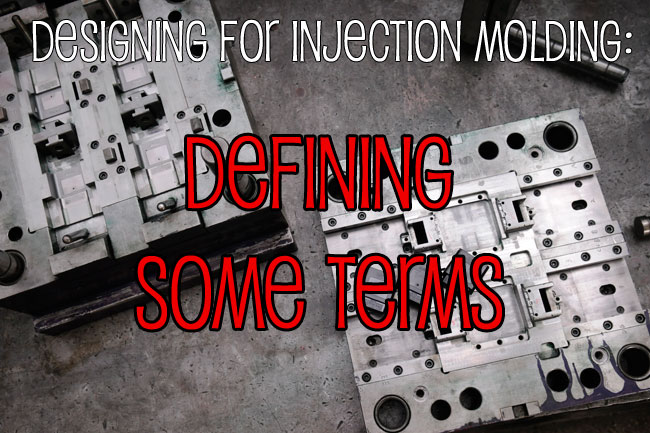A-Side and B-Side
Throughout this series, I’m going to be using some injection molding terms, so I want you to understand exactly what I mean.
Typical injection molds are made in two halves. During the injection process, the two halves are pressed and held together with tons of force while molten plastic is injected at high pressure through “gates” in one half of the mold. When the part cools, the two halves are separated, leaving the plastic part still stuck on the other half of the mold (typically the one without the gates). Ejection pins built into the mold push automatically the part out.
When a mold is manufactured to make your part, it’s designed so that the plastic’s outer surfaces will rest on one of two halves of the mold: the A-side or the B-side.
The half with the gates is the A-side and the half with the ejector pins is the B-side.
Plastic shrinks during cooling, and when it does, it adheres to the side with the most convex surface area.
As long as that half is the B-side (with the ejection system), it’s fine because the ejector pins will push the plastic off of the mold.
Sometimes minor changes to the design are required to make sure that the part will definitely stick to the B-side, but we’ll triple check this before we begin building your mold. And don’t worry…ensuring that the ejection system is correctly placed is our job here at RevPart.
Ejector Pins
Because your part is designed to stick to the B-side, you might need to tweak your design slightly to accommodate the ejector pins. It might be necessary to add a “landing pad” to accept the pressure of the ejector pins as they force your part out of the mold, but this isn’t necessarily a bad thing. Landing pads can also be used to reinforce curved walls and make your part stronger.
Sometimes instead of altering your part, we can alter the pin itself, contorting it to fit your part. More often than not, though, it’s easier and cheaper to make a few minor adjustments to your design. Plus, it might help with the overall functionality of your part by increasing its strength.
Knit Lines
A knit line is what happens when plastic flows coming from two different directions meet inside of the mold and solidify. The point of meeting creates a weak spot because the edges of the molten plastic, already cooling, don’t mix together very well.
Different plastics make different types of knit lines. Sometimes they’re nearly invisible so they don’t cause any cosmetic damage, but the weak spot still exists. On the other hand, some plastics are really prone to showing knit lines because the resin cools much too quickly or doesn’t flow fast enough through the mold.
Because knit lines are a weak part of your design, they’re a prime place for breakage.
There will be knit lines downstream from every gate (where we inject the plastic), but there’s still hope for your part. For example, having slightly thicker walls means the plastic will cool a little bit slower, giving the two edges of the flow more time to combine into a stronger seam. If your walls are too thin, the plastic may have a hard time filling your mold completely before it cools. Adding thickness to too-thin walls can greatly alleviate the problem.
So if you’re using filled material (like glass filled nylon), or if you’re putting additives like flame retardants into the resin, it can make the problem of weak or ugly knit lines worse. We’ll do everything we can to help alleviate the knit line problem. Our engineers will work with you to help determine the best place to put your gates to minimize knit lines.
Don’t want to miss any of the tips in this series? Subscribe to our newsletter to get them delivered straight to your inbox.
Introduction | Defining Some Terms | Plastic Choices



